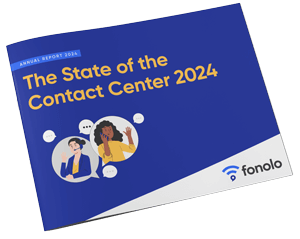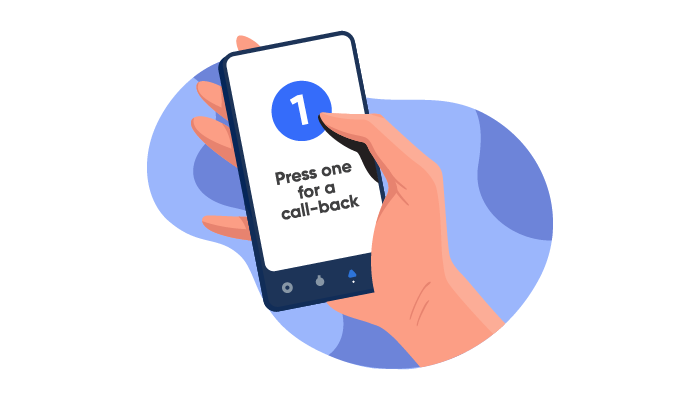Contact center managers know that virtual queuing technology is essential to keeping operations running smoothly. It underpins some of the most useful tools agents have to handle large and changing call volumes. Without it, mayhem would quickly ensue when calls come rushing into your contact center without any way to prioritize them or create order.
Instead of the chaos, picture this: shorter hold times, happier customers, and efficient call routing — all at your fingertips. In this blog, we’ll unpack how virtual queuing works, explore the capabilities of call-back software and share tips to help you optimize your contact center operations.
What is Virtual Queuing?
Virtual queuing simply refers to a system that lets a caller keep their place in line without sitting on hold. At its simplest, it’s a virtual version of the “take a number” system you might find at a deli. When your number is up, you’ll get a sandwich – or a call-back!
Today, the best call-back technologies go several steps further, facilitating a scenario where no one waits on hold and customers seamlessly move through queues, even selecting a future call-back time, without hitting a single bump in the road.
When calls are spiking, virtual queueing and call-backs give customers the kind of VIP treatment they expect by respecting their time and offering them an alternative to endless hold music. This innovative solution optimizes agent productivity too, by deferring calls to quieter times, and ensuring customers are happy so calls go smoothly. Call center managers take note: virtual queuing is a game-changer that elevates customer satisfaction while boosting operational efficiency.
How Does it Work?
Typically, virtual queuing software is used to hold a customer’s place in line while waiting to speak to an agent. The caller is offered a voice call-back when it’s their turn, and in the meantime, they are free to go about their day. Here’s the typical virtual queuing process:
- The process begins when a caller is offered a call-back as an alternative to waiting on hold. The offer might simply say: “Press 1 to receive a call back instead of waiting on hold.”
- The caller can then press ‘1’ to begin the virtual queuing process.
- Some behind-the-scenes technology takes over here when a queuing bot takes the caller’s place in the queue – with no change or compromise to the call experience or security.
- The customer is free to go about their day. Some virtual queue/call-back systems may send a text message along the way, to update them about their place in the queue.
- When their call reaches the front of the queue, it is connected to an agent, who then presses a button to call the customer back. This is known as an “agent first” system, meaning the agent is already on the call when the customer is called back, and the customer doesn’t have to wait twice.
Importance of Virtual Queuing in Contact Centers
Virtual queuing and call-back software results in lower call abandon rates and higher CSat rates.
Why? When call volumes increase, several things happen – none of them good. First of all, hold times increase. Callers get agitated, and agents do too, knowing there’s an endless queue of frustrated customers waiting on the lines. Important calls are missed and, if voicemail is used, an enormous backlog of messages accrues.
Call-backs free customers and agents from this inevitability. By selecting a call-back from the next available agent – or choosing a scheduled call-back at a later time – customers are free to go about their day. Agents are free to deal with incoming calls at a normal cadence, and customers are much less stressed. Scheduled Call-Backs do double duty by actually deferring call volume to a quieter period.
How Does Call Routing Fit In?
Call routing is another feature underpinned by virtual queuing technology. It’s a widely used tool that can connect customers to the right department, or perhaps to an agent who speaks the right language or who has the expertise to help with a specific problem. Call routing always starts with virtual queuing.
When it comes to smart, or predictive call routing, AI-powered software is integrated with virtual queuing software and employs algorithms to process and direct callers based on their call and purchase history, behavior profile, conversational style, personality, and other data points. Read more about call routing in our related blog!
Benefits of Call-Back Software in Virtual Queuing
There are many benefits to pairing robust call-back software with virtual queuing abilities. Customers love it and your improved CSat ratings and lower abandon rate will prove it. Call-backs also streamline your operations, allowing you to use staff more efficiently, eliminate needless downtime, and lower agent churn. Plus, call-backs are customizable, so you can tailor your call-back scheduling and preferences to fit your brand’s unique needs.
7 Tips for Contact Center Professionals
1. Understand your customer’s pain points
Before implementing virtual queuing and call-back technology, identify the pain points that are unique to your customers and have a clear understanding of how much hold time they will tolerate before abandoning their call. This will help you tailor your new tools to solve your real problems.
2. Choose the right technology
Research and invest in virtual queuing and call-back systems that integrate seamlessly with your existing contact center infrastructure. Fonolo can help. Our Call-Backs work with any platform and the setup is simple, with rich reporting and best-in-class customer support. Fonolo works on any device – voice, mobile, or web – and Fonolo Web Call-Backs seamlessly link your digital customers to the voice channel.
3. Provide clear communication
Inform customers about the option to join a virtual queue and request a call-back instead of waiting on hold. Offer estimated wait times and keep them updated with SMS notifications along the way. Use historical data and real-time monitoring to adjust estimates as needed to manage customer expectations effectively.
4. Offer call-back options
Give customers even more choice by offering Scheduled Call-Backs, which let them request a Call-Back at a convenient time rather than waiting on hold. Provide flexibility in scheduling Call-Backs to accommodate different time zones and preferences.
5. Personalize the experience
Collect relevant information from customers during the call-back request process, such as their preferred contact method and reason for calling. Use this information to personalize interactions and provide tailored solutions.
6. Integrate with multichannel support
Ensure that virtual queuing and call-back technology seamlessly integrate with other channels, such as live chat and email. This allows customers to switch between channels without losing their place in the queue.
7. Monitor and analyze performance
Continuously monitor key metrics like call abandonment rates, average wait times, and customer satisfaction scores, to gauge the effectiveness of your implementation. Seek feedback from customers and agents, too, then use this feedback to constantly improve.
By following these tips, contact center managers can get the most ROI from their virtual queuing and call-back technologies, while improving their customer and agent experience, and increasing operational efficiencies, too!

The State of the Contact Center 2024
Learn what industry experts and CX influencers say about the innovations and challenges impacting today’s contact center.

